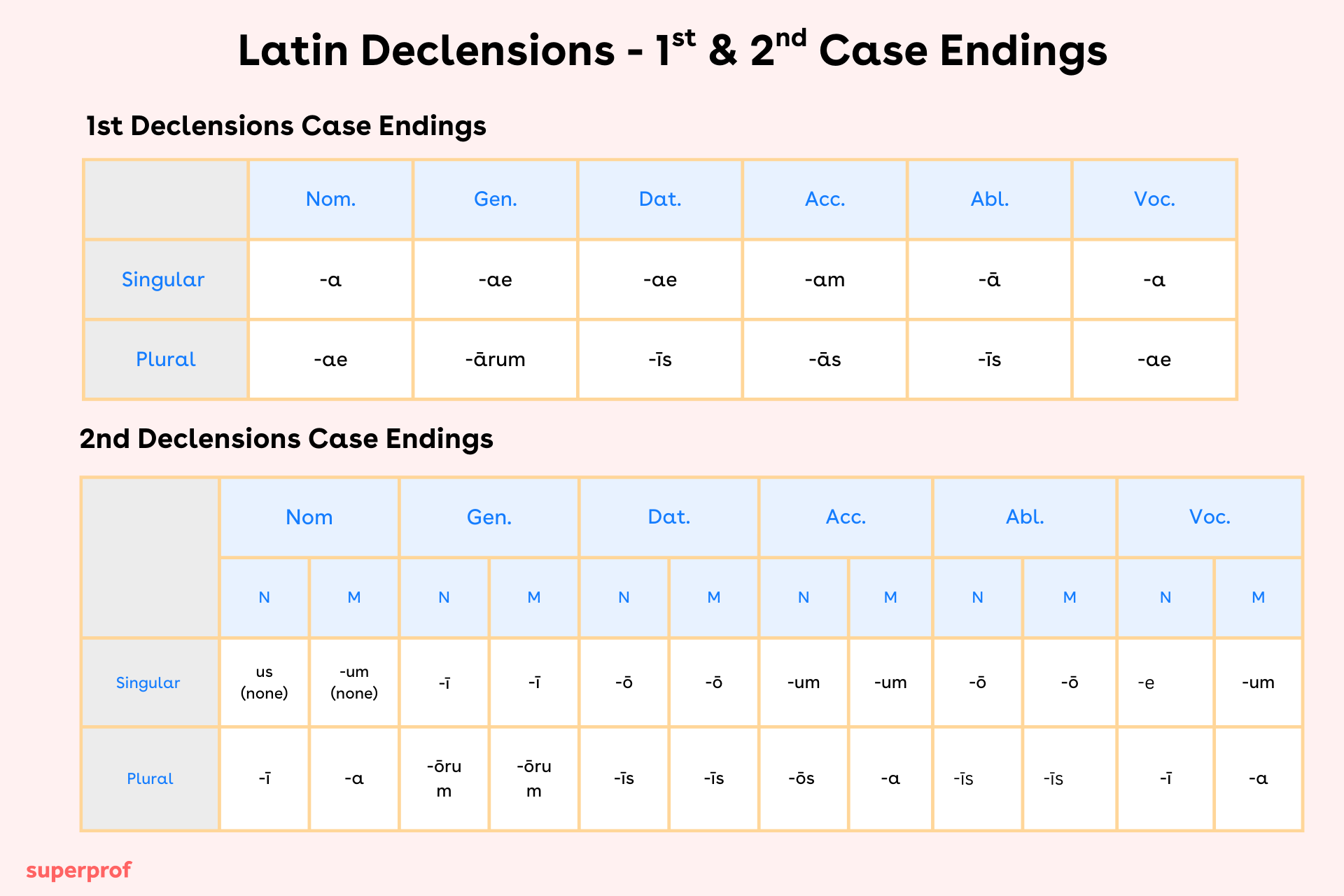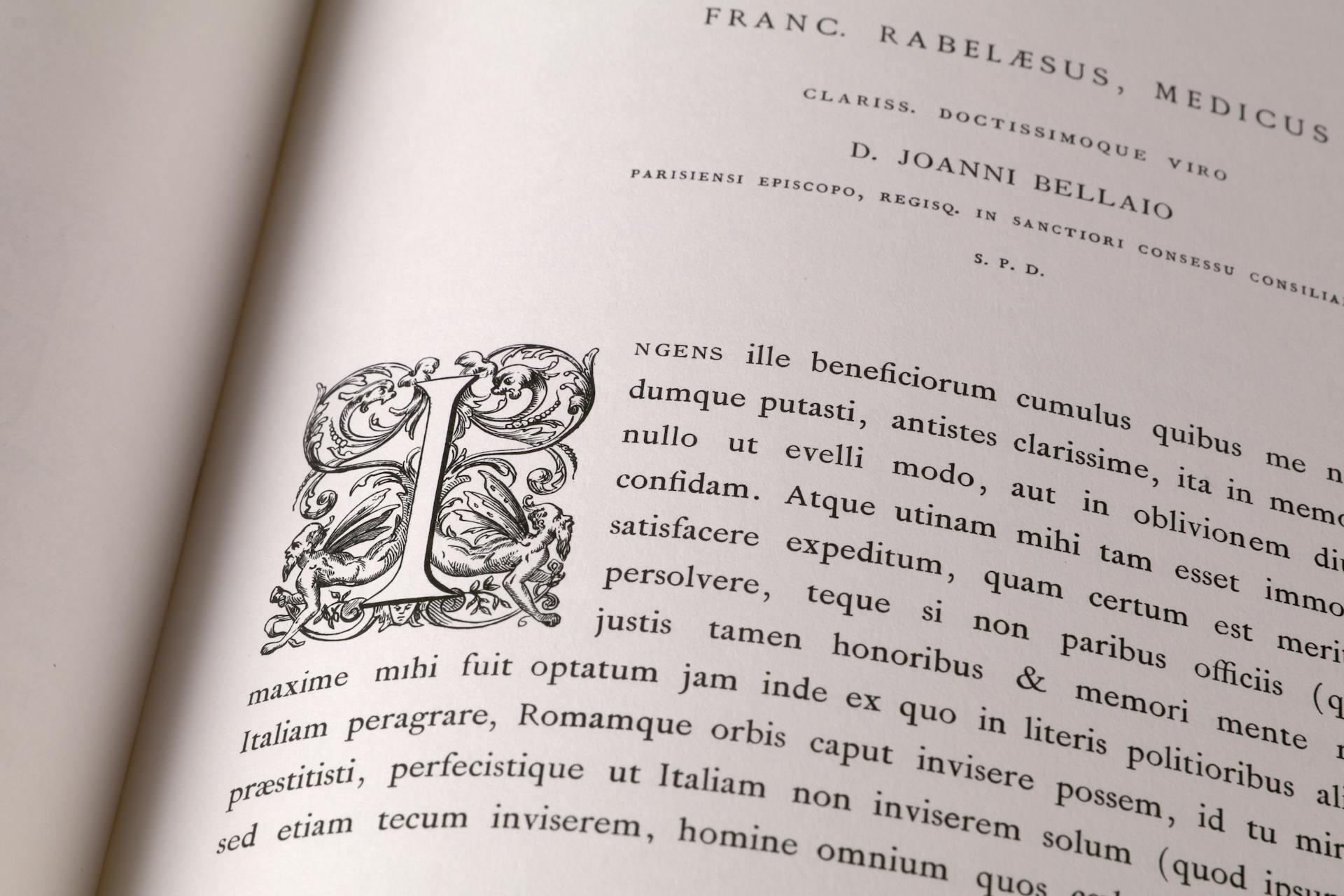For many Latin learners, declensions can feel like an early stumbling block - a point where progress slows to a halt. However, that's a natural feeling. After all, declensions follow a logic and structure that's pretty alien to most learners.
In order to get you back on track and moving towards fluency in Latin, this guide will walk through the cores structures that govern how Latin nouns change depending on their role in a sentence. Plus, you'll also learn smart, practical strategies for remembering these patterns and how you can put them into practice.
Here's a summary of all five Latin noun declensions, broken down by gender and case endings.
| Declension | Gender(s) | Nominative Singular Ending | Genitive Singular Ending | Example Noun | Meaning |
|---|---|---|---|---|---|
| First | Feminine | -a | -ae | puella | girl |
| Second | Masculine | -us / -er | -i | servus | slave |
| Second | Neuter | -um | -i | bellum | war |
| Third | M/F/N | Various | -is | rex | king |
| Fourth | Masculine | -us | -us | manus | hand |
| Fourth | Neuter | -u | -us | cornu | horn |
| Fifth | Feminine | -es | -ei | dies | day |

Latin Declension Endings Charts
Below is a quick summary chart showing all the standard case endings for Latin declensions. Don't forget to use it as a quick reference guide as you work through your Latin exercises.
Latin Declensions - 1st and 2nd Case Ending

Latin Declensions - 3rd Case Endings
The third declension is famously the hardest of the declensions to master, however, the endings follow a consistent pattern once you've distinguished gender and syllable types. Check out the full case ending chart below.

Latin Declensions - 4th and 5th Case Endings
The fourth and fifth declensions appear less regularly, but their endings are pretty regular and easy to spot. Here's a side-by-side chart showing their case endings by gender and number.

What Are Latin Declensions?

Before learning how Latin declensions work, it helps to understand exactly what the word declension actually means.
In Latin, to decline a word essentially means to change its ending to show its role in a sentence. These changes generally signal three things: case, number, and gender.
To decline a word means to change its from to show what it's doing in the sentence - like whether its the subject, object, or shows possession
This same system applies to nouns, pronouns and adjectives. However, interestingly enough verbs don't follow these patterns - they're conjugated and not declined.
The second word in a Latin dictionary entry is the genitive singular. Its ending (like -ae or -is) shows which declension the noun belongs to.
So simply put, a declension is a set of pattern endings that a word follows. There are five declensions in total, each having its own unique set of noun endings that is grouped by both form and grammatical gender. Still following?
What Are The Latin Cases and How Do They Work?
In Latin, a noun's role in a sentence (no matter whether it's the subject, object, or shows possession), isn't determined by word order like in English. Instead, it's shown through something called cases.

Each noun changes its ending depending on its case, and there are six that appear across every declension. Let's examine how they work in the chart below.
| Case | Function | English equivalent |
|---|---|---|
| Nominative | Identifies the subject of the sentence | The girl runs |
| Vocative | Used to directly address someone | O girl! |
| Accusative | Marks the direct object of the verb | I see the girl |
| Genitive | Shows possession or relationship | The girl's book/book of the girl |
| Dative | indicates the indirect object | I gave the book to the girl |
| Ablative | Used with prepositions: shows mean or separation | By the girl/with the girl |
Do you know about Latin's linguistic legacy?
How Do Latin Declensions Work in Practice?
At this point in the article, you should be beginning to grasp how Latin uses endings to show what a noun is doing in the sentence, right? Now it's time to see that that looks in action, as well as how each declension differs from the others in structure and usage.

What is the First Declension in Latin?

The first declension in Latin includes mostly feminine nouns and is recognizable by its genitive singular ending -ae. These nouns tend be fairly straightforward for beginners and often appear in early Latin texts. Let's look at how a noun like rosa (rose) declines across cases.
| Case | Singular | Plural |
|---|---|---|
| Nominative | Rosa | Rosae |
| Vocative | Rosa | Rosae |
| Accusative | Rosam | Rosas |
| Genitive | Rosae | Rosarum |
| Dative | Rosae | Rosis |
| Ablative | Rosa | Rosis |
How Does the Second Declension Work in Latin?
The second declension in Latin includes both masculine and neuter nouns, all marked by a genitive singular ending in -i. Below, we've used dominus (meaning master) to show how a typical masculine noun in this group is declined.

Masculine Second Declension Example - dominus, domini, m (master)
| Case | Singular | Plural |
|---|---|---|
| Nominative | Dominus | Domini |
| Vocative | Domine | Domini |
| Accusative | Dominum | Dominos |
| Genitive | Domini | Dominorum |
| Dative | Domino | Dominis |
| Ablative | Domino | Dominis |
not all second declension nouns are masculine, some are neuter and they follow an unusual rule: the nominative, vocative, and accusative forms are always identical - both in the singular and plural forms.
Nueter Second Declension Example - templum, tempi, n (temple)
| Case | Singular | Plural |
|---|---|---|
| Nominative | Templum | Templa |
| Vocative | Templum | Templa |
| Accusative | Templum | Templa |
| Genitive | Templi | Templorum |
| Dative | Templo | Templis |
| Ablative | Templo | Templis |

Why is the Third Declension So Varied?

The third declension covers a wide range of Latin nouns and can often be a bit overwhelming. However, once you spot the main patterns (i.e. the difference between parasyllabic and imparisyllabic forms), it becomes a lot more manageable.
Parisyllabic nouns have the same number of nominative and genitive syllables, whereas for imparisyllabic nouns, the genitive has one syllable more than the nominative
Masculine/Feminine Parisyllabic Example - civis, vis, m (citizen)
| Case | Singular | Plural |
|---|---|---|
| Nominative | Civis | Cives |
| Vocative | Civis | Cives |
| Accusative | Civem | Cives |
| Genitive | Civis | Civium |
| Dative | Civis | Civibus |
| Ablative | Cive | Civibus |
Neuter Parisyllabic Example - mare, maris, n (sea)
| Case | Singular | Plural |
|---|---|---|
| Nominative | Mare | Maria |
| Vocative | Mare | Maria |
| Accusative | Mare | Maria |
| Genitive | Maris | Marium |
| Dative | Mari | Maribus |
| Ablative | Mari | Maribus |
Masculine/Feminine Imparisyllabic Example - consul, consulis, m (consul)
| Case | Singular | Plural |
|---|---|---|
| Nominative | Consul | Consules |
| Vocative | Consul | Consules |
| Accusative | Consulem | Consules |
| Genitive | Consulis | Consulum |
| Dative | Consuli | Consulibus |
| Ablative | Consule | Consulibus |
Neuter Imparisyllabic Example - corpus, corporis, n (body)
| Case | Singular | Plural |
|---|---|---|
| Nominative | Corpus | Corpora |
| Vocative | Corpus | Corpora |
| Accusative | Corpus | Corpora |
| Genitive | Corporis | Corporum |
| Dative | Corpori | Corporibus |
| Ablative | Corpore | Corporibus |
Beware, there are false imparisyllabic nouns: these are nouns with two consonants at the end. For example: urbs, urbis (city); mens, mentis, f (mind); mons, montis, f (mountain) or cor, cordis, m (heart).
What is the Fourth Declension in Latin?
The fourth declension in Latin doesn't appear as often, but's easy to recognize thanks to the -us genitive ending. It mostly includes masculine or neuter nouns, with endings that stay consistent across different words.

Masculine/Feminine Fourth Declension Example - manus, manus, f (hand)
| Case | Singular | Plural |
|---|---|---|
| Nominative | Manus | Manus |
| Vocative | Manus | Manus |
| Accusative | Manum | Manus |
| Genitive | Manus | Manuum |
| Dative | Manui | Manibus |
| Albative | Manu | Manibus |
Neuter Fourth Declension Example - cornu, cornus, n (horn)
| Case | Singular | Plural |
|---|---|---|
| Nominative | Cornu | Cornua |
| Vocative | Cornu | Cornua |
| Accusative | Cornu | Cornua |
| Genitive | Cornus | Cornuum |
| Dative | Cornui | Cornibus |
| Ablative | Cornu | Cornibus |
How Does the Fifth Declension Differ From the Rest?

As for the fifth declension, there are only feminine nouns, with the exception of dies, ei, m (day) but which is also feminine when it means the date.
Feminine Fifth Declension Example - res, rei, f (thing)
| Case | Singular | Plural |
|---|---|---|
| Nominative | Res | Res |
| Vocative | Res | Res |
| Accusative | Rem | Res |
| Genitive | Rei | Rerum |
| Dative | Rei | Rebus |
| Ablative | Re | Rebus |
You can easily find all the Latin declensions in an English-Latin dictionary like the Oxford Latin Dictionary or even online.
Test your knowledge of Latin history and culture by identifying these 20 quotes!
Latin Memorisation Techniques
🔤 Mnemonic Devices
👀 Visual Aids
🎶 Music Exercises
♺ Repetition exercises
Now that you (hopefully) have a solid grasp of what declensions are, the next step is committing them to memory. So how do you make them stick? Below, we'll walk you through several memorisation techniques that can make remembering latin declensions a lot less frustrating.
Mnemonic Devices
Have you ever forgotten someone's name, only to remember it instantly once someone mentions the first letter? That's how mnemonic devices work - they give your memory a small nudge in the right direction.
You can try this by coming up with a fun or memorable phrase or rhyme that matches up with the endings in each declension.
For instance, you could use a rhyme like "A, ae, ae, am, a, a" for the first declension singular endings.
Mnemonics reduce the load on your working memory by anchoring info to a pattern or sound. Once that association is fully formed, it becomes much easier to recall complex information or instructions
Visual Aids
Many learners find that visual tools make a massive difference when it comes to helping them memorize declensions. If you're more of a visual thinker, using visual aids can help cement patterns way more effectively than just reading alone.
Flashcards 🃏
Start by making a flash card for each case ending by writing the case name on one side and Latin ending on the other. After you've done this, make a habit of testing yourself on a daily basis by flipping through them and saying the answers out loud.
Posters 🖼️
Design or print a wall poster that has all the declensions and their varying rules listed. Hang it up somewhere you'll see it every day (like above your desk), and you'll soon be surprised how much you begin to remember without actively trying.
Charts 📝
Alternatively, you could also together a simple table that lays out the case endings next to each other. This will make the patterns much easier to see and also give you something clear to check while studying at home.

To help remember the meanings of each case, you could try adding small images or icons to your visuals. For example, the nominative case shows the subject of a sentence, so you could use an image of a person doing something (like running) to help you remember it's the one doing the action.
Music Exercises
Putting declension endings to a melody is a pretty unique but highly effective way to commit them to memory. Just think about all of the television adverts that managed to get stuck in your head without you ever having to actively try to memorise them - there's a lot right?
To do this yourself, try thinking of a a tune you already know by heart (like twinkle twinkle little star or happy birthday), and sing the declensions endings out to that rhythm - it's that simple!
Having trouble making your own songs? Thankfully, there are plenty of latin songs online that cover the first few declensions in a fun and memorable way. Just check out the video below to see for yourself.
Check out these Latin lessons on Superprof.
Latin Repetition Exercises

Repetition is key if you want to turn knowledge into instinct. Once you've got a good feel for the declension endings, the goal should be to practice them until you don't have to think twice anymore.
Why not try this routine yourself?
- Say it out loud: pick a noun (e.g puella) and recite its declension from nominative, ablative, singular, and plural.
- Write it out: copy the full table from memory, then check and correct after you're finished. It's better to write this out on paper than type it on your phone or computer.
- Cover and test: Hide the answers, write what you remember and then mark your score. It sounds super obvious, but it's a great method for spotting what hasn't stuck yet.
- Space out your practice: Don't cram all declensions into one massive study session. Only review one or two a day and keep coming back to them on a regular basis.
Discover the history and evolution of the Latin alphabet...
Latin Declensions: Study with a Private Tutor!
If you get stuck and find learning Latin a real ordeal, you should consider taking private Latin lessons for beginners. Alongside your Latin tutor, you can try your hand at translating sentences and figuring out the correct declension and case of each noun that you come across.
In the statement "puella aquam bibit" (The girl drinks water), "puella" suggests that it serves as the subject, just like how "aquam" indicates its functions as the direct object.
Having a tutor by your side as you practice will eliminate a lot of the trial and process that comes with language learning, and it will also ensure that you are kept on the right path along the way!
On top of all that, a tutor also gives you structure. You'll have goals to reach every week, feedback personalised to you, and someone to guide you through your practice step by step.
On Superprof, there are tons of Latin teachers offering lessons for all levels, as well as thousands of other teachers in all Latin languages. So, are you ready to test yourself on the Latin declensions? Now find the answers to all of your questions about the Latin language...
















I enjoyed the parasylabic imparasylabic explanation.
thanks a lot. really helped me to get an overview
the “singular” versus the “feminine”
The Latin declensions are explained in grammars, not ‘history books’. Grammar is pre-historical. :)
Thank you soo much, it was a great help!!
There is a mistake in the 5th declension grid.
Columns are named: Case|Singular|Feminine instead of Case|Singular|Plural
Salut fort,
Je ravis de bien vouloir participer à votre cours en ligne .J’apprécie beaucoup
Salut fort,
Je suis ravis de bien vouloir participer à votre cours en ligne .J’apprécie beaucoup
Question is there a free lesson to learn Latin as a beginner
Or a audiobook to listen and also to be able to read from to learn the sounds how it is said as I’m reading the words to be able to put them into a sentence into a paragraph any suggestions on a audiobook as I said to listen and to learn to read greatly appreciate it
That’s a fantastic question! If you’re starting out with Latin, a few free resources can help:
Text + Audio: The Lingua Latina per se Illustrata series often comes with companion recordings so you can hear correct pronunciation while following the text.
Audiobooks & Podcasts: Look into Latinitium and Coffee Break Latin (podcast), which blend listening practice with grammar and vocabulary.
Free Courses: The Cambridge Latin Course (online) offers beginner-friendly lessons with some audio support.
Pairing reading with listening is a great way to internalise pronunciation and sentence structure. You might also want to check if your library has Latin audiobooks available for free.